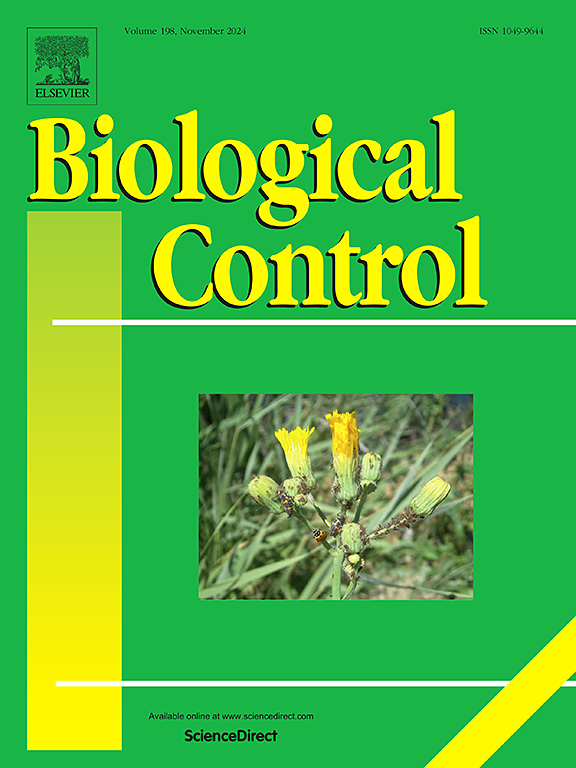在半干旱有机农业中应用生物防治剂点状锈菌管理
IF 3.4
2区 农林科学
Q2 BIOTECHNOLOGY & APPLIED MICROBIOLOGY
引用次数: 0
摘要
点锈菌是一种专性真菌病原体的卷叶草,一个常见于温带生态系统的多年生根状杂草。鸢尾草在有机农业中是难以管理的,需要进行综合管理以减少其丰度和对作物的影响。点状锈菌限制了葡萄树的生长,但其影响尚未在田间研究中量化。以美国蒙大拿州半干旱地区4年有机一年生作物序列为研究对象,研究了(1)点状棘豆(P. punctiformis)(发生率,对症茎密度)和弓形棘豆(C. arvense)(茎密度,相对生长率[RGR])对耕作(标准vs减少)的响应,以及这两个变量之间的关系;(2)终年作物茎密度对耕作和点状棘豆斑块感染的响应。随着时间的推移,减少耕作增加了点状线虫的发生率和有症状的茎密度。在表现出症状性感染的少耕斑块中,香卷草茎密度随时间的推移而下降。马尾松RGR随斑块出现点状螺旋体症状性感染的年数增加而下降,而在无症状的少耕处理中亦是如此。标准耕作条件下终年作物茎密度较高,减少耕作条件下随年数增加茎密度升高。减少耕作的做法通过增加其传播和症状性感染来补充现有的点状拟虫的影响,这是以前确定的使用点状拟虫作为生物防治剂的两个挑战。当与补充策略相结合时,生产者可以将点状弓形虫整合到半干旱有机农业杂草管理中,可能有助于减少弓形虫对作物的影响。本文章由计算机程序翻译,如有差异,请以英文原文为准。
Integrating Puccinia punctiformis, a biological control agent, into Cirsium arvense management in semi-arid organic agriculture
Puccinia punctiformis is an obligate fungal pathogen of Cirsium arvense, a perennial rhizomatous weed common in temperate ecosystems. Cirsium arvense is difficult to manage in organic agriculture and integrated management is necessary to reduce its abundance and impact on crops. Puccinia punctiformis limits C. arvense growth but its effect has not been quantified in cropland field studies. In a four-year organic annual crop sequence at a semi-arid site in Montana, USA, we evaluated (1) P. punctiformis (occurrence, symptomatic stem density) and C. arvense (stem density, relative growth rate [RGR]) in response to tillage (standard vs. reduced), and the relationship between these two variables, and (2) final year crop stem density in response to tillage and P. punctiformis patch infection. Reduced tillage increased P. punctiformis occurrence and symptomatic stem density through time. Cirsium arvense stem density decreased through time in reduced tillage patches that displayed symptomatic infection. Cirsium arvense RGR decreased with increasing years that a patch had P. punctiformis symptomatic infection, and in the reduced tillage treatment regardless of symptoms. Final year crop stem density was higher under standard tillage but increased under reduced tillage with increasing years that a patch had P. punctiformis symptomatic infection. Reduced tillage practices complemented the impact of existing P. punctiformis by increasing its spread and symptomatic infection, two challenges previously identified with using P. punctiformis as a biocontrol agent. When coupled with complementary tactics, producers can integrate P. punctiformis into semi-arid organic agriculture weed management, potentially helping reduce C. arvense’s impact on crops.
求助全文
通过发布文献求助,成功后即可免费获取论文全文。
去求助
来源期刊

Biological Control
生物-昆虫学
CiteScore
7.40
自引率
7.10%
发文量
220
审稿时长
63 days
期刊介绍:
Biological control is an environmentally sound and effective means of reducing or mitigating pests and pest effects through the use of natural enemies. The aim of Biological Control is to promote this science and technology through publication of original research articles and reviews of research and theory. The journal devotes a section to reports on biotechnologies dealing with the elucidation and use of genes or gene products for the enhancement of biological control agents.
The journal encompasses biological control of viral, microbial, nematode, insect, mite, weed, and vertebrate pests in agriculture, aquatic, forest, natural resource, stored product, and urban environments. Biological control of arthropod pests of human and domestic animals is also included. Ecological, molecular, and biotechnological approaches to the understanding of biological control are welcome.
 求助内容:
求助内容: 应助结果提醒方式:
应助结果提醒方式:


